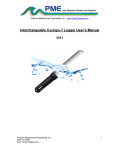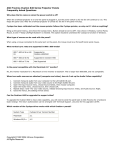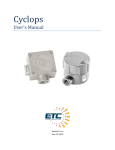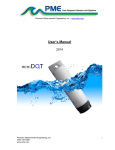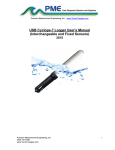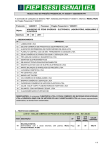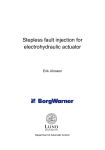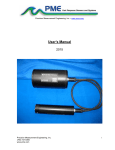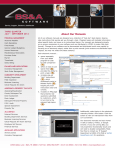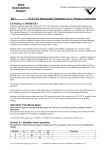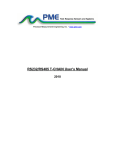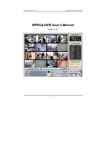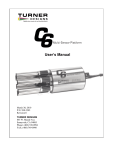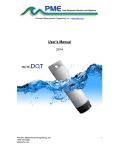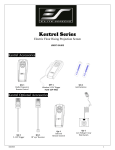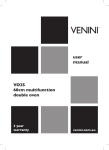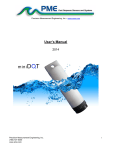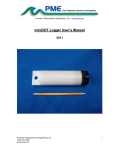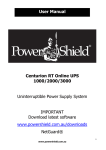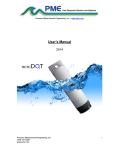Download Fixed Sensor Cyclops-7 Logger User`s Manual
Transcript
Precision Measurement Engineering, Inc. • www.Turner Designs.com Fixed Sensor Cyclops-7 Logger User’s Manual 2013 Precision Measurement Engineering, Inc. (760) 727-0300 www.Turner Designs.com 1 (INTENTIONALLY BLANK) Precision Measurement Engineering, Inc. (760) 727-0300 www.Turner Designs.com 2 Warranty 1-YEAR LIMITED WARRANTY Precision Measurement Engineering, Inc. warrant that the Logger shall be free of defects in workmanship and materials, under normal use, for a period of one year from the date of shipment. This warranty is made only to the original purchaser. In the event a Logger covered by this warranty fails to operate according to our published specifications, then return it freight pre-paid to Precision Measurement Engineering or an authorized Service Provider. Precision Measurement Engineering (PME) will repair the unit at no charge to the customer and bear the cost of return shipment to customer. Carefully pack all components, as the customer is responsible for any freight damage. This warranty does not apply to services or consumable / expendable items (such as batteries, fuses and ropes) required for general maintenance. The Cyclops-7 sensor, manufactured by Turner Designs, is warranted only to the limit of the warranties provided by their original manufacturer. PME makes no warranty, either expressed or implied, that the sensors will be operable after they are exposed to adverse environmental conditions, such as biofouling, oil fouling, freezing temperatures or others. This warranty is void if, in our opinion, the Logger has been damaged by accident, mishandled, altered, or repaired by the customer, where such treatment has affected its performance or reliability. In the event of such treatment by the customer, costs for repairs plus two-way freight costs (no COD shipments will be accepted) will be borne by the customer. In such cases, an estimate will be submitted for approval before repair work is started. Items found to be defective should be returned to PME carefully packed, as the customer will be responsible for freight damage. Incidental or consequential damages or costs incurred as a result of the product malfunction are not the responsibility of PME. For all warranty or non-warranty returns please obtain, complete, and submit a RMA to PME. This RMA form may be obtained at http://www.pme.com/HTML%20Docs/RMAform.html After submission of this form, then PME will respond with a RMA number. Please place this number on all shipments and related communications. Precision Measurement Engineering, Inc. (760) 727-0300 www.Turner Designs.com 3 Safety Information BURSTING HAZARD Should water enter the Cyclops-7 Logger and come into contact with the enclosed batteries, then the batteries may generate gas causing the internal pressure to increase. This gas will likely exit via the same location where the water entered, but not necessarily. The Cyclops-7 Logger is designed to release internal pressure as the end cap is unscrewed, prior to the disengagement of the end cap threads. If internal pressure is suspected, then treat the Cyclops-7 Logger with extreme caution. Revision History Date 29-DEC-2011 10-JAN-2012 01-SEP-2012 14-DEC-2012 17-JAN-2013 11-FEB-2013 14-MAR2013 09-MAY-2013 28-AUG-2013 05-NOV-2013 11-NOV-2013 13-NOV-2013 19-NOV-2013 23-DEC-2013 24-DEC-2013 14-JAN-2014 20-MAR2014 20-MAR2014 2014SEP21 Revision Description Copied from miniDOT manual (Revised 20-DEC-2011) Added corrective action to LED flash table. Updated for new RS232 software – extensively revised Revised screen shots of Cyc7Calibrate and Cyc7Plot Removed Sec 3.7 Serial port commands and Appendix 1 Pictures revised. Set Sample Interval description added Added description of sensor type tag on SD card holder Added more detailed description of calibration procedure. Added words concerning Turner’s Solid Secondary Standard Added battery pack warning Reworded serial port driver to jspWin, removed Cyc7Service Reworded Chapter 2 software installation Removed Time Zone selection Updated description of how time is set Updated battery pack removal to remove SD card for ‘C’ pack Updated to include exchangeable sensor Replaced “exchangeable” with “interchangeable” Corrected 2-flash reference to Sec 3.11 to reference 3.8 Updated to include “Fixed” in header name. Removed information regarding Interchangeable logger. Created Fixed Logger manual only. Added sensor cover info to Sec 1.2 and added calibration description to Sec 2.4 Precision Measurement Engineering, Inc. (760) 727-0300 www.Turner Designs.com 4 CONTENTS Chapter 1 Quick Start 1.1 Calibrate and Go 1.2 A Few Details Chapter 2 Software 2.1 2.2 2.3 2.4 Overview Software Installation Cyc7Plot Cyc7Calibration Chapter 3 Cyclops-7 Logger 3.1 3.2 3.3 3.4 3.5 3.6 3.7 3.8 3.9 Overview Opening and Closing the Logger Electrical Connections and Controls Connection to Serial Port File Close Button Battery Replacement File Management SD Card Interchangeable Sensor Installation Precision Measurement Engineering, Inc. (760) 727-0300 www.Turner Designs.com 5 Chapter 1: Quick Start 1.1 Calibrate and Go Your Cyclops-7 Logger has arrived completely ready to go. PME produces two types of loggers, one with sensor permanently installed and a logger with a connector that you will use to plug in your own sensor. You have been provided with the Fixed Cyclops-7 Logger, which contains a Cyclops-7 sensor that has been permanently installed. The logger/sensor are shipped in an un-calibrated state. The logger itself is set to measure temperature and concentration once every 10 minutes and record 4 files of measurements daily. You need only calibrate the sensor. In this condition the Cyclops-7 Logger will operate for roughly half a year before the internal battery is expended. At the end of the deployment period you need only to open the logger, press the File Close button, switch off the power, and remove the SD card. Your temperature and concentration measurements, together with a time stamp indicating the time the measurement was made, are recorded in text files in the DATA directory on the SD card. These files can be copied from the SD card onto any host computer. Files can be concatenated and displayed using the Cyc7Plot software supplied with the logger. Follow these steps to start the deployment, logging Cyclops-7 output and Temperature once each 10 minutes: 1) Calibrate the sensor/logger as described in Chapter 2, Cyc7Calibrate program. 2) Open the Cyclops-7 Logger (if not already open from calibration) as described in Chapter 3. 3) Slide the power switch to the ON. The LED will flash once. Observe the LED for up to 90 seconds. Sometime during this period it will flash 5 times indicating that logging has begun. If it flashes continuously, then see section 3.5 of this manual. 4) Inspect the o-ring seal for debris. 5) Close the Cyclops-7 Logger by screwing the white housing back onto the black end cap. 6) Deploy the Cyclops-7 Logger. Follow these steps to end the deployment 1) Recover the Cyclops-7 Logger 2) Clean and dry all accessible surfaces. 3) Open the Cyclops-7 as described in Chapter 3. Precision Measurement Engineering, Inc. (760) 727-0300 www.Turner Designs.com 6 4) Press the File Close button. The LED should begin continuous flashing. 5) Slide the power switch to the OFF position. 6) Remove the SD card (both screws must be removed to extract SD card). Use a card reader and a host computer to copy the files located in the DATA directory onto the host computer. These text files contain the measurements. 7) (Optional – but strongly recommended) Run Cyc7PLOT.jar program to see a plot of measurements, and to produce a concatenated file containing all the measurements. This file contains better time information and is much more useful than the files collected directly by the logger. Remove the battery if storing the Cyclops-7 Logger for extended periods. 1.2 A Few Details The previous section gives instructions for sampling at 10-minute intervals. However there are a few additional details that will enhance use of the Cyclops-7 Logger. Sensor cover – The sensor guard is the long tube having slots in the end that covers the Turner C7 sensor. This guard not only protects the sensor but also establishes a consistent field of view for the sensor. The guard must be used when the sensor is calibrated and also when it is used for measurements in the field. Sampling rate – The Cyclops-7 Logger records measurements at equal time intervals. The default time interval is 10 minutes. If a formatted SD card is placed in the Cyclops-7 Logger and the power is turned on, then the logger will record every 10 minutes. However, it is also possible to instruct the Cyclops-7 Logger to record at different intervals. This is accomplished by connecting a Windows computer to the logger and using software supplied for this purpose. See Chapter 2. Sample intervals of less than 1 minute or longer than 1 hour are not allowed and will be rejected by the Cyclops-7 Logger software. The Cyclops-7 Logger will flash its LED repeatedly if it encounters a sample interval request outside this range. Sample Time – The Cyclops-7 Logger records the time that each is made. It does this based on an internal clock. When your Cyclops-7 Logger arrives it is set by PME to UTC (formerly known as Greenwich mean time (GMT)). We suggest that you leave it always set to UTC so that there is never a time question in the recorded measurements. Subsequent software implements conversion to local time. You can reset Cyclops-7 Logger time to local time if you choose by using software. See Chapter 2. The Cyclops-7 Logger internal clock will drift in the <10 ppm range (< about 30 seconds/month) so you should plan to reset it occasionally. File Information – The Cyclops-7 Logger software creates 4 files daily. The number of measurements in each file will depend upon the sample interval. Files are named Precision Measurement Engineering, Inc. (760) 727-0300 www.Turner Designs.com 7 by the time (Unix epoch 1970) that the file is opened based on the logger’s internal clock and expressed in hexadecimal format. (Use the Cyc7Plot program to concatenate these files into a more useful format. See Chapter 2) Cleaning the Sensor – The sensor may be cleaned by unscrewing the black sensor guard and gently wiping the optical face. Battery Life – The Cyclops-7 Logger consumes battery power mostly from the Cyclops-7 sensor, but also slightly from simply keeping track of time, writing files, sleeping, and other activities. The Cyclops-7 Logger will record approximately 30,000 total samples and will operate for up to a year when powered by the battery pack (2 X alkaline ‘C’ cells) supplied by PME. Keep a general record of Cyclops-7 Logger number of samples. It is not possible to accurately determine the charge state of the battery pack from measurements of its terminal voltage. If you have a general idea of the number of samples already obtained on a battery, then you can make a guess as to how many more samples remain. Err on the side of caution. The 2 X ‘C’ battery pack holds the batteries very tightly. The holder itself is glued to the aluminum chassis. Take care when changing batteries that the glue joint is not broken. Always use the paper tube supplied with the Cyclops-7 to contain the batteries. Use only new batteries as replacements. Coin Cell Battery Life – The Cyclops-7 Logger uses a coin cell for backup of the clock when the power is switched off. This coin cell will supply roughly 2 years of clock operation, but this is only required if the main power is off. Should the coin cell discharge it must be replaced. Coin cells are not user-replaceable. O-Ring and Seal – When the cover is screwed on, it passes along the o-ring located in the end cap several revolutions. Keep this o-ring lightly lubricated with silicone grease or oil compatible with buna-N o-ring material. When the Cyclops-7 Logger is opened after deployment, a small number of water drops are deposited on the inner surface of the o-ring. When the pressure housing is screwed back on, these drops become trapped inside the Cyclops-7 Logger. Be sure to carefully dry the o-ring and adjacent surfaces (especially underneath) prior to closing the Cyclops-7. Re-lube the o-ring at this time. Remove any debris from the drying process. Closing the Logger – The logger is much more difficult to open than to close. Screw the white logger housing onto the black cap until the housing touches the cap. No further tightening is necessary. SD Card – If the retaining screws are lost or not re-installed, the SD card can be ejected from its socket if the Cyclops-7 Logger is dropped on its pressure housing end. The logger will be unable to log should this occur. If the retaining screw is lost Precision Measurement Engineering, Inc. (760) 727-0300 www.Turner Designs.com 8 the SD card can be taped in place using a bit of electrical tape. Use only SanDisk 2 GB SD cards as replacements. THE SD CARD IS NOT HOT-SWAPPABLE. POWER MUST BE SWITCHED OFF PRIOR TO INSERTING OR REMOVING THE SD CARD. IF THIS IS NOT DONE, DAMAGE TO THE SD CARD MAY RESULT. LED Indications – The Cyclops-7 Logger performs various tests as it begins logging operations. If any test fails the software flashes the LED light and re-conducts the test. In general if a test fails once it will continue to fail and the LED light will continue to flash. The following table gives the number of flashes and the reason these flashes appear. LED Flash # 1 2 3 4 5 Reason Corrective Action Normal. Presented immediately after power is switched on. Indicates that the CPU has started its program. Error. No SD Card or SD card not completely plugged in. None required. Normal operation. Error. Requested sampling interval less than 1 minute or greater than 1 hour. Error. Clock not initialized. Normal, presented once after roughly one minute, indicating that the miniDOT Logger is starting logging operation. Plug SD card correctly. Install new SD card. Re-format SD card (Sec 3.8) Check CAL.TXT file on SD card (Sec 1.2). Reset clock (See TIME command Sec 3.9 and Appendix 1). None required. Normal operation In addition to LED flashing, the Cyclops-7 Logger internal software prints statements while doing internal testing just after the power is switched on. These statements can supply more information than the LED flashes. See Section 3.5 for additional information. Precision Measurement Engineering, Inc. (760) 727-0300 www.Turner Designs.com 9 AutoRanging – The Cyclops-7 sensor has three output ranges: 1X, 10X and 100X. The best of these ranges is automatically selected by the logger based on the voltage measured of the sensor. The logger software remembers the best range and, at each sample time, first measures sensor output voltage using this range. Software then reviews this voltage to determine if the range was appropriate. In most cases the range will be appropriate and the measurement is recorded. However sometimes software determines that a different range would yield a better measurement. In this case software selects a new “best range” and re-measures the sensor output voltage using this range. This new best range becomes the range selected at the next sample time. The best range is determined as follows: Sensor Voltage Divided by Range 0.00 to 0.04 0.04 to 0.4 0.4 and higher Best Range 100X 10X 1X Should the first voltage measurement be unacceptably close to the sensor maximum output voltage (an over-range condition) the first voltage is re-measured using range of 1X and the best range calculated. This range becomes the best range and software proceeds as above. Calculation of Engineering Units – Engineering units are calculated from voltage measurements of the sensor and from information gained during calibration (see Chapter 4). The result of calibration is the following information: Name Vz1 Vz10 Vz100 S Definition Voltage output of sensor in zero solution on range 1X Voltage output of sensor in zero solution on range 10X Voltage output of sensor in zero solution on range 100X Sensitivity of sensor Vz1, Vz10, and Vz100 are measured with the sensor in a solution of zero concentration. S is determined from the voltage output of the sensor using the “best range”, described above, with the sensor in a reference solution of known concentration. The user must enter the concentration value of this solution, given the name C. The sensor voltage is measured in this solution and given the name Vs. The following table shows how S is determined. Range 1X 10X 100X S S = C / (Vs – Vz1) S = 10.0 * C / (Vs – Vz10) S = 100 * C / (Vs – Vz100) Precision Measurement Engineering, Inc. (760) 727-0300 www.Turner Designs.com 10 Note that since only one calibration concentration is actually measured, there is only one S determined. However this S is used to compute engineering units from the other ranges should these be implemented by the logger during the measurement of samples. Engineering units are computed as shown in the following table: Range 1X 10X 100X EU EU = S * (Vs – Vz1) EU = S * (Vs– Vz10) / 10.0 EU = S * (Vs– Vz100) / 100.0 Engineering units computed using the same range that was used to determine S will be more accurate than engineering units computed using other ranges since the sensor may not exactly implement ranges. For example the 100X range may actually be implemented by circuitry as 100.1X but the calculations would use 100X. Precision Measurement Engineering, Inc. (760) 727-0300 www.Turner Designs.com 11 Chapter 2: Software 2.1 Overview The Cyclops-7 Accessory Kit includes software to calibrate the sensor, and concatenate and display Cyclops-7 Logger data files. These programs are designed to operate on a Windows computer. 2.2 Software Installation Software operation requires a Windows operating system computer. Both 32 and 64 bit computers are supported. Install the software by copying the files below into any folder on your computer’s hard drive.. There are four files and two folders: • • • • • Cyc7Plot.jar – Concatenate logger data files and plot. Cyc7Calibration.jar – Facilitate calibration of sensor. jspWin.dll – library of java RS232 software interface to Windows operating system (32-bit is the default) 32 Bit PC Serial Driver folder 64 Bit PC Serial Driver folder Cyc7Plot and Cyc7Calibration are Java language programs that require the host computer to have the Java Runtime Engine V1.6 or later installed. This engine is commonly required for internet applications and will likely already be installed on the host computer. Should this not be the case the JRE can be downloaded via internet from http://www.java.com/en/download/inc/windows_upgrade_xpi.jsp Cyc7Calibrate communicates with the host computer’s serial port. It requires a serial port driver, jspWin.dll. The jspWin.dll in the files supplied is the 32 bit version. If your computer is operating a 64 bit JRE, delete jspWin.dll. In it’s place copy the jspWin.dll from the 64 Bit PC Serial Driver folder. The correct (32 or 64 bit) jspWin.dll must be present in the same folder as Cyc7Calibrate. If your computer does not have a serial port (these are called COM ports on Windows computers) you must supply a serial-to-USB adapter. These are supplied by PME or can be purchased from some other source. These adapters usually require that you install a driver. For PME’s adapter follow instructions supplied with the adapter. Click on Cyc7Plot or Cyc7Calibrate to run the program. 2.3 Cyc7Plot Precision Measurement Engineering, Inc. (760) 727-0300 www.Turner Designs.com 12 Cyc7Plot performs two services: • • It concatenates all the measurement files it finds in the selected directory and writes these as CAT.TXT, and it displays the concatenated measurements. When Cyc7Plot runs it presents the screen shown below. Select the DATA folder. This is the folder that contains your Cyclops-7 Logger measurement files. This folder MUST NOT contain any other files. This folder can be on the SD card from the Cyclops-7 or it can be from a copy of this on your computer’s hard drive. Press ‘Process’ to begin measurement processing. The software reads all Cyclops-7 Logger data files in the Data Folder, writes a CAT.TXT file in the same folder, and finally presents a plot of the measurements similar to the plot shown below. Example CAT.TXT file: Precision Measurement Engineering, Inc. (760) 727-0300 www.Turner Designs.com 13 You may zoom this plot by drawing a square from upper left to lower right (click and hold left mouse button) that defines the zoom region. To zoom completely out, attempt to draw a square from lower right to upper left. Right click on the plot for options such as copy and print. The software may be run multiple times at the same time (select Data Folder, press Process, select new Data Folder, press Process...). In this case it produces multiple plots. Presently the plots are presented exactly on top of each other and so when a new plot appears it is not obvious that the old plot is still there. It is. Just move the new plot to see it. Closing any plot closes all. The software can be re-run at any time. In this case it simply reads the Cyclops-7 Logger measurement files again and, after asking permission, overwrites the CAT.TXT file. 2.4 Cyc7Calibrate The Cyc7Calibrate program provides these services: • • • It enables time setting (based on internet timeserver clock), it enables sample interval setting, and it enables calibration of the sensor. Turner C7 sensors, and PME loggers, are not factory calibrated. Calibration must be physically performed by the customer. Calibration consists of an experiment where Precision Measurement Engineering, Inc. (760) 727-0300 www.Turner Designs.com 14 the sensor is exposed to two solutions, the first having 0 concentration of the sensed material (chl-a, rhodamineP whatever the C7 sensor senses) and a second solution having a known concentration created by the customer. Cyc7Calibrate software records sensor output in each solution and creates a linear fit to these two points. After calibration the Cyclops 7 Logger will measure sensor output and record it in engineering units using this linear fit. Turner C7 sensors are optical devices that operate by sending colored light into the water and observing how much light returns. The field of view available to these sensors is quite important in establishing their response. PME’s Cyclops 7 Logger is supplied with a sensor cover that not only protects the sensor from damage but also establishes the field of view. This cover has slots near where it covers the sensor so that exterior water can enter and be sensed. The sensor cover must be in position when the sensor is calibrated and must be in the same position when the sensor is used. A small amount of light can exit through the sensor cover slots, be reflected by the container holding the calibration solution, and return. Calibrate the sensor in black containers. Exterior light such as room lighting or sunlight can enter through the slots and cause a very small measurement effect. Attempt to calibrate in the same lighting as the system will experience in field use. Be sure that there are no bubbles trapped in the cover or stuck on the sensor. Calibration proceeds by dipping the system in one solution and then the next. Take care not to transport one solution to the next. Mix two 0 solutions and two solutions of the sensed material. Label one each as the “calibration” and one each as the “wash” When moving the sensor back and forth first dip the sensor in the wash then into the calibration. The most noticeable effect is when the 0 solution is contaminated prior to calibration. If the 0 solution is really 1, and if this is not noticed and the value 0 is entered into Cyc7Calibrate, then later in a truly 0 solution the Cyclops 7 Logger will be indicated as a concentration of –1. A negative concentration can not exist and so the sensor is suspected of poor measurement when the problem really is that it was poorly calibrated. Cyc7Calibrate requires that the host computer be connected to the Cyclops 7 Logger at the time the calibration is performed. The logger must be open at this time. Take care that no calibrating solutions splash onto logger circuits. When calibration is completed, use the sensor to log measurements in each calibration solution. Do this right away using the same solutions that were used for calibration. The values 0 and the known concentration should be recorded. This gives a check on the results of calibration. Cyclops-7 Loggers support various Turner Cyclops-7 sensors. The sensor type is shown on a small tag on the SD card holder. Precision Measurement Engineering, Inc. (760) 727-0300 www.Turner Designs.com 15 When Cyc7Calibrate runs it first displays the following dialog. Yes, the software really means it! The Cyclops-7 Logger MUST FIRST be connected to the computer COM port (or to a USB-to-COM adapter that is itself already connected to the computer with proper driver installed) and THEN the logger power turned on. When the logger is powered its internal software first checks to see if the logger is connected. If so, software becomes responsive to commands and presents a steady LED indication, if not software begins logging measurements and will NOT respond to Cyc7Calibrate commands. See Chapter 3 for instructions on opening the logger and connecting the serial port. After “OK” is pressed the Cyc7Calibrate user interface appears” Precision Measurement Engineering, Inc. (760) 727-0300 www.Turner Designs.com 16 The first task is to connect to the Cyclops-7 Logger. This is accomplished by selecting the COM port (or to a USB-to-COM adapter) where the logger is connected. Connection is accomplished in response to the Connect button. Upon successful connection the button turns green and various information is read from the logger. If the host computer is connected to the internet, the current difference between an internet time server’s time and the Cyclops-7 Logger internal clock will be displayed next to the Set Time button. If this difference is acceptable the clock need not be set. If the computer is not connected to the internet a message will appear and the Set Time button will not be enabled. To set the clock, click on the Set Time button. Software will set UTC time based upon an internet time server’s clock. Time set will replace the time error displayed. The Cyclops-7 sampling interval is set in response to the Set Sample Interval button. Enter the desired interval and click on the button. The value shown initially is the current value read from the logger. Precision Measurement Engineering, Inc. (760) 727-0300 www.Turner Designs.com 17 Sensor calibration requires that you provide two reference solutions. One solution will be the ‘zero’ (sometimes called the ‘blank’) solution and will contain none of the material being sensed. The other solution, the ‘calibration’ solution, will contain a known quantity of the material being sensed. It may also be that the calibration is a solid standard. This calibration quantity must be no more than the measurement range of the sensor on its 1X scale but it can be less. See Chapter 1 for a description of sensor ranges. Sensors are calibrated in response to the Calibrate button, after both the Unit of Measure and the Calibration Value are entered. Enter the unit of measure that is appropriate for the Cyclops 7 sensor mounted on the logger. Enter the calibration value for the solution. Click on the Calibrate button. The adjacent scroll bar shows how far the program has progress through the calibration procedure. Precision Measurement Engineering, Inc. (760) 727-0300 www.Turner Designs.com 18 A dialog window appears instructing you to place the sensor in the zero solution. This will most likely simply be clear water contained in a bucket. Whatever the solution, the sensor after calibration will report 0 when returned to this solution. Click OK when the sensor is suitably positioned. At this time the software reads information from the sensor, selecting all three ranges of the sensor sensitivity. Precision Measurement Engineering, Inc. (760) 727-0300 www.Turner Designs.com 19 When this is completed a Zeroing of sensor completed dialog appears. Click OK. Precision Measurement Engineering, Inc. (760) 727-0300 www.Turner Designs.com 20 A “Please place sensor in calibration solution of <Calibration Value> (<Unit of Measure>)” dialog appears. In the screen shot above the value of 50.0 (NTU) is displayed. This information is taken from the Unit of Measure and Calibration Value text boxes and will be whatever is entered in the boxes. Place the sensor in the calibration solution. Whatever the solution, the sensor after calibration will report the calibration value (50 NTU in the above example) when returned to this solution. Click OK. At this time the software reads information from the sensor, selecting the best sensitivity range. When this is completed a “Calibration completed” dialog window appears along with the actual calibration results. Precision Measurement Engineering, Inc. (760) 727-0300 www.Turner Designs.com 21 Click OK. You may (and should!) now save the results on disk by clicking the Save Results. Note that the calibration has been installed in the sensor and the sensor is calibrated no matter if the results are saved on disk or not. If you choose to save the results a file save dialog appears. You must create a name for the calibration file, including the appropriate suffix. The .txt suffix is suggested since software saves a text file. You may read the saved file later using a text file editor. A note about Turner solid state secondary standards: These standards are not supplied with any calibration value, so they are not at first useful for calibration. However, once the sensor is calibrated the solid state secondary standard can be placed onto the sensor and adjusted so that the sensed value is some arbitrary value. Please refer to Turner’s documentation concerning the Solid Secondary Standard that is supplied with the standard or via the internet: Precision Measurement Engineering, Inc. (760) 727-0300 www.Turner Designs.com 22 http://www.turnerdesigns.com/t2/doc/instructions/998-6800.pdf Install the standard as described. The logger’s sensor guard must be unscrewed and removed for this procedure. Operationally, adjustment of a standard is not well implemented in the logger software. Step 2 of theUse of the Solid Secondary Standard for in vivo Chlorophyll Applications on page 1 of this document assumes that the sensor output can be viewed in real time. However this output can only be logged by the Cyclops-7 Logger. A short recording of the measurement must be made, and then the record reviewed, to determine the sensed value. The process must be repeated by trials to adjust the standard as described in the document. Precision Measurement Engineering, Inc. (760) 727-0300 www.Turner Designs.com 23 Chapter 3: Cyclops-7 Logger 3.1 Overview All of the Cyclops-7 Logger measurements pass from the sensors onto the SD card it contains. Measurements may flow from the logger to host computer by removing the SD card and copying the contents. Customers will be required to open the logger each time measurements are obtained. This chapter describes the logger internal features. 3.2 Opening and Closing the Logger The logger circuitry is contained in a waterproof housing that must be opened. The housing is opened by unscrewing the white pressure housing from the black end cap. Turn the pressure housing counter clockwise relative to black end cap. Close by reversing this procedure after being sure that the o-ring is free from debris. Lube oring occasionally with grease intended for buna-n o-ring material. The logger is much more difficult to open than to close. Screw the white logger housing onto the black cap until the housing touches the cap. No further tightening is necessary. Precision Measurement Engineering, Inc. (760) 727-0300 www.Turner Designs.com 24 3.3 Electrical Connections and Controls Removal of the cover reveals the logger connections and controls, shown below. The SD Card contains data files and the calibration file. These are described elsewhere in this manual. Note that the battery pack and one screw must be removed to remove the SD card. The LED Light is a yellow LED. This is used to indicate different features described elsewhere in this manual. The File Close Button causes the program to save the current file and halt measurement logging. Press this button prior to switching power off. If you switch off without pressing this button nothing really bad happens but the last file that could contain up to 6 hours measurements will be forgotton. The Serial Port Connection allows communication between the logger and an external computer. Communication parameters are 9600 baud with 8 bits, no parity, and one stop bit. The external computer must have a communication program such Precision Measurement Engineering, Inc. (760) 727-0300 www.Turner Designs.com 25 as Hyperterminal (for PC) or equivalent, a connecting cable, and must have a serial port or USB to serial adapter. The Cyc7Calibrate and Cyc7Service programs use this connection. Plug the connection cable supplied with the Cyclops-7 Logger into this connector. Plug opposite end to the host computer’s COM port. The On/Off Switch connects or disconnects battery power to the logger. In the ‘Off’ position the logger is completely without power except for the clock circuit. Note that ‘On’ and ‘Off’ positions are marked in white letters on the circuit board nearby the On/Off Switch. The Main Battery provides main power to the Cyclops-7 Logger. 3.4 Connection to Serial Port The Cyclops-7 Logger must be connected to a host computer to use the Cyc7Calibrate and Cyc7Service software. It can also communicate with a terminal program such as Hyperterminal. Connect the Cyclops-7 Logger to a host computer by plugging the connection cable into the RS232 connection within the Cyclops-7 Logger. Connect the opposite end (9-pin D connector) to the host computer’s serial port. On a PC desktop this is the COM port. Some computers may not implement a COM port in which case the serial Precision Measurement Engineering, Inc. (760) 727-0300 www.Turner Designs.com 26 port must be emulated by using a USB to Serial converter. PME supplies a serial-toUSB converter in the Cyclops-7 Accessory Kit. In addition to the physical connection, the host computer may run a terminal program such as Hyperterminal. Windows 2000 and XP ship with Hyperterminal located at programs|accessories|communication. Later Windows operating systems do not. The Cyclops-7 Logger communicates as shown in the table below. Appendix 1 shows how to set Hyperterminal for this protocol and gives other information about communications programs. In general, Customers should not need to use software besides Cyc7Calibrate to communicate with the Cyclops-7 Logger. Feature Baud Rate Bits sent per byte Parity Stop bits sent Flow control Parameter 9600 (bits/second) 8 (bits) none 1 (bit) none 3.5 File Close Button The logger records individual measurements to the SD card file when the measurement is made. After each measurement the file remains open. If the power fails or is switched off while the file is open, then the file information is lost. Files are recorded 4 times daily so only as much as 6 hours of measurements are at risk. The user must inform the Cyclops-7 software that the power is about to be switched off by pressing the File Close button. The software will detect this action and close the presently open file. Thereafter the logger will halt its mission, flash its LED repeatedly. There is no way to exit this loop except by turning the logger power off. 3.6 Battery Replacement Carefully remove both “C” cells, noting the direction of the (+) terminals. These both are oriented towards the SD card and circuit. Insert new ‘C’ cells into the paper tube and re-install the pair into the battery holder. Take care not to break the glue connection between the holder and the aluminum chassis. 3.7 File Management The Cyclops-7 Logger writes 4 data files daily onto the SD card. These are text files that contain the measured data. These files contain the serial number of the Precision Measurement Engineering, Inc. (760) 727-0300 www.Turner Designs.com 27 Cyclops-7 Logger that wrote the file and also a time stamp for each measurement. The Cyclops-7 Plot software reads all these files and produces a CAT.TXT file that contains the original data plus extra information. The recommended method of file management is the following: 1) Deploy the Cyclops-7 Logger for a period, and recover it. 2) Remove the SD card and place in a card reader on a host Windows computer. 3) Run Cyclops-7 Plot, selecting the DATA directory on the SD card. This creates the CAT.TXT file in the SD card DATA directory. 4) Create a folder on the host computer for this Cyclops-7 Logger deployment. Copy all files in the SD card DATA directory to this folder. Keep deployments of the same Cyclops-7 logger in separate folders. Keep files from separate Cyclops-7 sensors separated as well. 5) Delete all files in the SD card DATA directory. File management may be handled in other ways, but in any event be sure that the SD card DATA folder is empty prior to beginning a deployment. If it is not empty nothing bad happens but unpredictable Cyclops-7 Logger operation may occur if the number of files becomes large, roughly over 1000 files. 3.8 SD Card THE SD CARD IS NOT HOT-SWAPPABLE. POWER MUST BE SWITCHED OFF PRIOR TO INSERTING OR REMOVING THE SD CARD. IF THIS IS NOT DONE, DAMAGE TO THE SD CARD MAY RESULT. Cyclops-7 is supplied with a 2 GB SD card. Alternates can be purchased and used with Cyclops-7. Use only SanDisk 2 GB SD cards. Cards manufactured by other manufacturers may work also but PME has tried SanDisk. In any event use only 2 GB capacity cards. Format every card prior to using with Cyclops-7. Format cards only on a PC computer running a Windows operating system. Other computers or operating systems may work but PME has tried only Windows. When formatting, select FAT, not NTFS or FAT32. Do not provide a volume label nor select Quick Format. Here is the correctly set Windows 2000 Format dialog: Precision Measurement Engineering, Inc. (760) 727-0300 www.Turner Designs.com 28 The SD card is retained by a small screw that must be removed prior to removing the SD card. If the retaining screw is lost, the SD card can be ejected from its socket if the Cyclops-7 Logger is dropped on its pressure housing end. The logger will be unable to log should this occur. If the retaining screw is lost the SD card can be taped in place using a bit of electrical tape. Precision Measurement Engineering, Inc. (760) 727-0300 www.Turner Designs.com 29





























